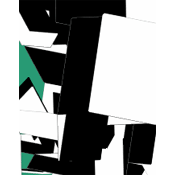 |
|
 |
 |
 |
 |
 |
  |
compte rendu
MANFRED MOHR AT THE BITFORMS GALLERY
NEW YORK, WINTER 2006
 The unlikely muses of the square and its twin, the cube, have visited many and, of those, infatuated most.
One contemporary casualty is the German expatriate artist Manfred Mohr who, in the first months of the New Year, had an exhibition at the Bitforms Gallery in Chelsea (his second there in three years).
Mohr has been toying with cubes since the 1970s; although the shape's presence may be found in his earlier ventures, his interest in the cube coincided with popular access to computers.
Since that time, Mohr has been wholly devoted to generating algorithms which by turns elaborate, deconstruct, or simply accentuate the basic twelve lines that go into this fundamental geometric form.
Half of the pieces at Bitforms showed Mohr's most recent forays into cube-territory, the subset series; the others were past examples of his rather rectilinear trajectory.
The unlikely muses of the square and its twin, the cube, have visited many and, of those, infatuated most.
One contemporary casualty is the German expatriate artist Manfred Mohr who, in the first months of the New Year, had an exhibition at the Bitforms Gallery in Chelsea (his second there in three years).
Mohr has been toying with cubes since the 1970s; although the shape's presence may be found in his earlier ventures, his interest in the cube coincided with popular access to computers.
Since that time, Mohr has been wholly devoted to generating algorithms which by turns elaborate, deconstruct, or simply accentuate the basic twelve lines that go into this fundamental geometric form.
Half of the pieces at Bitforms showed Mohr's most recent forays into cube-territory, the subset series; the others were past examples of his rather rectilinear trajectory.
In characterizing Mohr's preoccupations, it would be simplest, if inaccurate, to repeat the old cubist chestnut/canard: the artist aims to present an object from multiple perspectives.
Mohr goes well beyond this, geometrically, and aims to present an object - which becomes an idea - from directions and dimensions we probably have not conceived of: the subset series, he suggests, captures an "11-D hyper-cube." (This is a culmination of lesser-D endeavors, including 4-, in the 1970s, and 6-, in the 1980s.)
While the practicalities and prospects of such multi-dimensional cubes are beyond the present author, the complexity of Mohr's theory is evident in their rendering.
The subset.motion pieces are viewed on LCD screens, as black and white cubes (if they can still be called cubes at this level of abstraction) almost imperceptibly explode and contract, their shimmering, pixilated edges running aground of each other. Only the odd dead pixel interrupts the mesmeric quality of the screens, which are placed one beside the other.
The subset stills, which amount to freeze-frames of the subset.motion animations, are perhaps more compelling; printed on a canvas five times the size of the comparatively small screens, their levels of color registration are deeply pronounced, the black richer than that of the LCDs. Cube positioning and articulation is also marked, and Mohr achieves a kind of abstract expressionist origami.
Dimensionality is the most pronounced difference between Mohr's work in the 2000s and the rest of his oeuvre.
Origami can now be used as a reference-point; this is not the case with decades past, when his projects evoked cartography, mathematical equations, and hieroglyphics: flattened space, representative concepts, 2-dimensionality.
Mohr encourages these topographical interpretive strategies in some of his titles - random walk, visual equations - as well as in form - certain "equations" were printed in books, sculptures mimic skylines, and visual palindromes are a recurring structure.
At this stage Mohr was mostly using a plotter to render his algorithms, and with it he produced some marvelous work.
White Noise, at 1971 the earliest piece on display at Bitforms (the link, to a another entry in his series, does not do it justice), is so near to text one feels that, given time, a message might be discerned. Its title preempts any such endeavor: the meaning is, and is communicated through, static.
The same is true of most of what Mohr calls his Cubic Limit period, where a private, textual Esperanto is elaborated.
It is a pity that Bitforms did not have access to his earliest, pre-algorithmic work.
Infused with Moholy-Nagy, it suggests beguiling areas entirely unpursued by computer art, and reminds us that at one time Mohr concerned himself with other shapes, notably the circle.
Zeichnung A, in particular, is an entirely ludic interaction with the integrity of a shape.
Boundaries are collapsed; outlines are modified or simply crushed.
This description could apply to all of Mohr's work, and while it would be fascinating to see what he might do with the circle at this stage (Malevich, after all, did not only paint a Black Square), one can surmise based on Mohr's cubes.
subset and subset.motion in some respects inaugurate a new conception of space for Mohr, while in others merely continue along the same quizzical course - what one might call his personal algorithm.

Manfred Mohr's website
Patrick Ellis

 haut de page haut de page
 retour retour
|
|
 |
 |
 |
|
